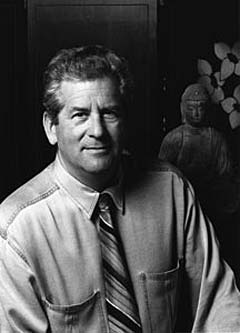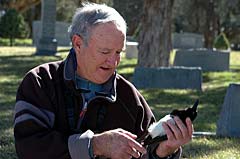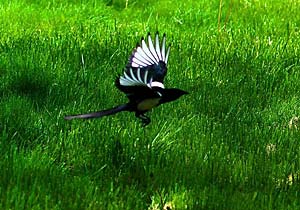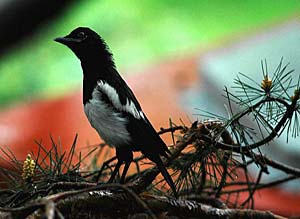May 27, 2005
Air Date: May 27, 2005
FULL SHOW
SEGMENTS
Arms to Space
View the page for this story
Death stars and ray guns may be the stuff of science fiction, but some government officials are hoping offensive space weapons will be a reality in the coming decades. Host Steve Curwood talks with Ashton Carter, former Assistant Secretary of Defense for International Security Policy under the Clinton Administration, about developments that could launch these weapons in space. (07:45)
Pthalates
View the page for this story
Researchers have known for years that phthalates, a family of chemicals found in paints, pesticides, and consumer products like shampoo, soap, and makeup, can have detrimental effects on genital and reproductive development in male rats. Now for the first time, a study looks at possible impacts on male human babies. Host Steve Curwood talks to Shanna Swan, one of the study's authors, about the results. (04:20)
Plugging into Trees
/ Eric WhitneyView the page for this story
Eric Whitney from member station KRCC in Colorado Springs reports on efforts to turn forest waste into electricity by chopping up dead trees and vegetation and mixing the chips in coal fired power plants. (07:15)
Planting the Seed
View the page for this story
Recently leaked information showing that rats fed a Monsanto corn variety may have developed kidney and blood problems is sending ripples throughout the European community. The questions raised from the study could further jeopardize the altered corn’s release in Europe. A recent European Union vote left the matter undecided, and further action is expected later this year. Dr. Brian John from the organization GM Free Wales spoke to host Steve Curwood about the study and about Europe’s view of GM food. The interview is followed by a discussion with Mark Schapiro of the Center for Investigative Reporting, who talks about the process of approval for GM products in the American market. (07:00)
A Son's Remembrance
View the page for this story
Mark Lappe, the noted toxicologist and medical ethicist, who helped shape many of the nation’s environmental and health policies died earlier this month. His son, journalist Anthony Lappe has a remembrance. (03:00)
Emerging Science Note/Schooled Sleep
/ Katie ZemtseffView the page for this story
Living on Earth's Katie Zemtseff reports on how more schooling could help women sleep at night. (01:20)
Mad about Magpies
/ Guy HandView the page for this story
Producer Guy Hand tells the story of the much-maligned Magpie, the bird everyone loves to hate, and why the critter deserves a break. (15:00)
This week's EarthEar selection
listen /
download
Show Credits and Funders
Show Transcript
HOST: Steve Curwood
GUESTS: Ashton Carter, Brian John, Anthony Lappe, Mark Shapiro, Shana Swan
REPORTER: Guy Hand, Eric Whitney
NOTE: Katie Zemsteff
[THEME MUSIC]
CURWOOD: From NPR, this is Living on Earth.
[THEME MUSIC]
CURWOOD: I’m Steve Curwood - It’s been known exposure to a family of widely used chemicals called phthalates can cause abnormalities in male sex organs in lab animals. Now for the first time a study shows exposure to phthalates can alter genitals in human babies.
SWAN: The boys were more likely to have less fully descended testicles and also shorter or smaller penis size and their scrotums were smaller and less distinct.
CURWOOD: Common chemicals and baby boys, this week on Living on Earth. Also, why one of Nature’s most hated birds deserves a break. The magpie reconsidered.
SPEAKER: We see them come in and take a robin nest and, you know, eat the babies and we’re all upset by that and we think of them as these nasty thieves kind of thing. Well in fact they’re not thieves, they’re just trying to raise their own young.
CURWOOD: Those stories are just ahead. Stick around.
[NPR NEWSCAST]
ANNOUNCER: Support for Living on Earth comes from the National Science Foundation and Stonyfield Farm.
[THEME MUSIC]
Arms to Space
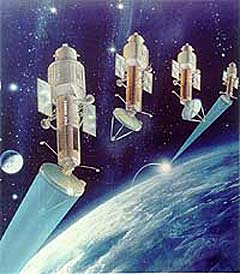
U.S. Air Force depiction of deployed Space-Based Laser constellation. (Photo: U.S. Department of Defense)
CURWOOD: From the Jennifer and Ted Stanley Studios in Somerville, Massachusetts, this is Living on Earth. I’m Steve Curwood.
As the world’s mayors gather in San Francisco for World Environment Day and celebrate the 60th anniversary of the United Nations, a renewed debate over weapons in space underscores how the earth indeed is but one giant ecosystem. Today, there are U.S. satellites to survey enemy movements with ultra-high resolution and Global Positioning Systems to guide aircraft, naval vessels, and ground forces. Many of these space capabilities are defensive in strategy.
But like Presidents before him, President Bush is now being urged to fund research that could lead to the deployment of offensive space weapons.
With me to talk about just how feasible such weapons might be is Ashton Carter. He was Assistant Secretary of Defense for International Security Policy under the Clinton Administration, had a hand in writing the 1996 national military space policy, and now teaches at Harvard. Mr. Carter, hello.
CARTER: Hello, good to be with you.
CURWOOD: Um, please give us a brief overview of the kinds of space weapons that are being developed today. I understand that there’s everything from satellite-destroying lasers to earth-targeted uranium missiles or rods?
CARTER: Oh, most of the concepts that people are talking about they’ve been talking about all the time that I’ve been in Defense. I was, uh, as a young pup I worked for Casper Weinberger– people have been talking about these same things. There are lasers that are in space that shine down on the ground and start fires. Missiles that are launched from space to the ground. Uh, there are just lumps of material, or rods of metal, that you de-orbit, and they come screaming down to the ground and bump into a building. So there are various ideas of this kind.
CURWOOD: You said most ideas are old. What new concepts might be kicking around that are encouraging these kinds of discussions?

U.S. Air Force depiction of deployed Space-Based Laser constellation. (Photo: U.S. Department of Defense)
CARTER: I really don’t think – and I’m a physicist by training – I don’t think there are any technological breakthroughs that have occurred. Uh, I think you’re seeing a renewal of an old debate rather than the dawn of new technology in this field. Um, if you put a laser – you can’t just park a laser over your enemy, because you, if you just put a satellite over enemy territory it falls to the ground. So you have to put your weapon not over enemy territory but in orbit over enemy territory. And when a satellite or a weapon is in orbit it’s here this moment, but then in a few minutes it’s over some other country, and in a half an hour or 45 minutes or so it’s over Australia and it doesn’t do you any good. So the fact that the earth is round and that uh, weapons have to be in orbit means that for every weapon you want over your target, you have to put lots of them in orbit. And so these are the kinds of reasons. And, of course, it’s very expensive to put things in orbit. These are the reasons why it’s much easier, cheaper, more efficient to drop a bomb from an airplane than to drop a bomb from space.
CURWOOD: How much further can we go now in militarizing space without putting weapons up there?
CARTER: Um, well, we can go a very substantial way. For example, one thing that’s on the drawing board is satellites that talk to each other by laser beam and create an Internet in the sky. Another is a space-based radar satellite – uh, in fact, a constellation of them – that can see through clouds, and so you would have a continuous record, like one of those cameras at a bank.
CURWOOD: Mmhmm
CARTER: Then if you had like, for example, a terrorist attack, you can watch the terrorists drive away from the site. You’ll have a record of it just like you have a record of a bank robber robbing a bank. So there are lots of interesting things that would improve the performance of our forces, and that fall short of actually putting weapons into space.
CURWOOD: Um, who are our potential competitors in space?
CARTER: Well the Russians still have a large military space program, as the Soviet Union did, and the Soviet Union really was trying to compete with us one on one. Uh, Russia’s now too poor to continue that program, and you see the gradual decay of a lot of the former Soviet Union’s military satellite constellations. But, while that’s going on, the Chinese are up and coming, they’re launching more and more satellites. The Israelis have military satellites. The Japanese have military satellites in space. The Europeans do. So we’re by no means the only one. But just as we have the most sophisticated and proficient military in the world in general, it’s also true that we have the most proficient and sophisticated military space program of any country in the world.
CURWOOD: Now, there’s no ownership or any international boundaries set in space, so what would we be violating exactly if we were to put weapons up in space?
CARTER: Well we would not be violating anything if we, unless we put nuclear weapons into space. There is a treaty that prohibits putting nuclear weapons into space. Otherwise it’s perfectly within the law to put a weapon in space. The United States has thought twice about doing so, mostly because it’s not economical or useful to put weapons into space. But also because we are so heavily dependent upon the use of space ourselves that it didn’t seem like a good idea to call attention to that fact, or to stimulate others to put weapons into space that might disrupt our satellites that we’re using for military purposes.
CURWOOD: Now in the press it would seem that there are a number of strong advocates for, uh, offensive space weapons in the Bush Administration right now. What do you make of that push for offensive weapons in space? And at the end of the day, what do you think it says about the Bush Administration’s security agenda?
CARTER: There are those in the Bush Administration, and certainly those on Capital Hill, who believe that there are good options, effective options, for deploying missiles in space. There are always enthusiasts to do various things in the military system. You remember President Reagan had Star Wars, and in the end none of that was deployed for the very simple reason – not because anybody was wimpy – but because it didn’t work very well and cost a lot of money.
CURWOOD: So from your perspective this isn’t something that is right or left, but simply unworkable?
CARTER: It’s largely not right, not left, it’s just not attractive as an investment, and I think a lot of these schemes will collapse of their own technical and budgetary weight rather than because one side or other of the policy argument wins.
CURWOOD: Ashton Carter is a professor of Science and International Affairs at Harvard University, and was Assistant Secretary of Defense for International Security Policy under the Clinton Administration. Mr. Carter, thanks so much for taking this time with me today.
CARTER: Good to be with you.
[MUSIC: “The Ascent” Hans Zimmer: Music Inspired by the Film K2 (Varese Sarabande) 1991]
Pthalates
CURWOOD: Studies by the Centers for Disease Control show that most people in the United States carry in their bodies concentrations of a family of synthetic chemicals known as phthalates. Phthalates are commonly found in plastics, pesticides, and personal care products like shampoos, soaps, and makeup. Phthalate exposure has been linked to malformed sex organs in male lab animals. Now, for the first time, there is a human study linking mothers exposed to phthalates to genital birth defects in male infants. The research is in the journal Environmental Health Perspectives and its’ lead author, Doctor Shana Swan, of the University of Rochester Medical School, joins me now. Dr. Swan, what exactly did you find?
SWAN: Well, um, we found that when the mother had higher levels of certain phthalates in her urine while she was pregnant, the boys produced had incomplete masculinization. Specifically, we found that a measurement that we call “anal-genital distance” was shorter when the mother was exposed to higher levels of certain phthalates. So, what is that? Well, the anal-genital distance can be measured pretty easily in young baby boys from the center of the anus to the upper insertion of the penis. It’s about twice as long in boys as in girls. In addition, the boys were more likely to have less fully descended testicles and also shorter or smaller penis size as measured by the volume. And their scrotums were smaller and less distinct.
CURWOOD: Now, just because this distance was shorter and the genitals were smaller doesn’t necessarily mean that this is a bad thing, does it? I mean, some people are shorter than others, that’s not necessarily a bad thing. Or is it a bad thing?
SWAN: Having a shorter anal-genital distance is a reflection of less virilization– pushes the boy toward the direction of the feminine. And, um, this is something that, in rodents, has led to a lot of problems later in the rodents’ lives such as decreased fertility, decreased sperm count, and eventually testicular cancer.
CURWOOD: Now you’re study says that as many as a quarter of the women in this country have levels of phthalates in their bodies higher than the levels you found in your research. Tell me, uh, to what extent do these chemicals accumulate in body tissue? And what’s the pathway for exposure to them, in adults?
SWAN: Right. Well, actually, for most of the phthalates we studied, and particularly the four that we found associated with genital development in boys, they are present in almost every female of reproductive age in the United States. So they’re extremely common. And the pathway is really unclear. They can come in through dermal exposure, through cosmetics, for example, putting on hand cream and so on. They can come in through your food or through your water. So we have ingestion, we have dermal exposure. And inhalation is probably the least likely, although they are in hairsprays and perfumes as well. So we have multiple routes of exposure and, um, multiple sources as well.
CURWOOD: What, if anything, can be done to reverse this stunted development of boys’ genital tracts in the womb? To what extent are supplements available that mothers could take to counteract the effects of these substances? Or substances that maybe they should avoid?
SWAN: Um, nothing is known about whether this is reversible, but from all the evidence we have, at least in rodents, this is a permanent change. There’s probably nothing that can be done once the development has been established. As to what women could do to prevent it, that’s very difficult, because consumers cannot know at this point what’s in the products they buy. So if you go to the store to buy, uh, makeup or some other household or personal care product, you will not know whether there’s a phthalate in there. I think an action that could be taken is we need to press for more consumer right to know about what’s in the products that we buy and put in our bodies and give to our children.
CURWOOD: Shana Swan is a professor of obstetrics and gynecology at the University of Rochester. Her study is published in Environmental Health Perspectives. Thanks for taking this time with me today, Dr. Swan.
SWAN: Nice to talk to you, Steve.
CURWOOD: Coming up: From cost to conservation. Turning the threat of forest fires into an opportunity to generate greener power. Keep listening to Living on Earth.
Related link:
Environmental Health Perspectives' published study on pthalates
[MUSIC: “Hey, Mister Jessie” The Johnny Nocturne Band: Wild & Cool (Bullseye) 1998]
Plugging into Trees
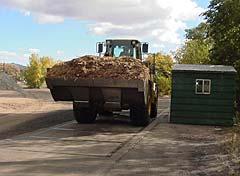
Aquila gathers biomass for use at it's W.N. Clark Generating Station in Canon City, CO (Photo: Aquila Inc., Colorado Operations)
CURWOOD: Across America, there are tens of millions of acres of forests that are dangerously overgrown with scrub-brush and small trees. Dangerous, because too much of this dried out vegetation can turn what were once healthy and limited natural fires into catastrophic blazes that roar through habitat without regard to homes and property. Removing this overgrowth without clear cutting is expensive. So the hunt is on for ways to find a use for this wood that will help pay for its removal. Eric Whitney of KRCC in Colorado Springs reports on efforts to turn forest waste into electricity.
WHITNEY: In Colorado, it’s easy to find forests that look and feel like they’re about ready to burn.
TOELLE: Yeah, this would be pretty typical, except, the one thing that’s interesting about this, I noticed is, for some reason, there was a lot more pinon back further to the west of us.
WHTINEY: Dave Toelle, a fire ecologist with the federal Bureau of Land Management, or BLM, shows me one such forest on the edge of Canon City. Toelle says the ongoing drought in the West has weakened the pinon pines here, and a beetle infestation has finished off about a third of them. They’re just standing there, dry, combustible and dangerous.
TOELLE: Look how thick it is. With a wind-driven, hot, dry day type scenario, which is pretty typical, we wouldn’t have a chance of doing much with anything in this landscape.
WHITNEY: That means a fire could easily sweep into the forested subdivision next door. So the BLM spent hundreds of man hours cutting down and shredding the dead pines on land next to the homes to create a buffer between the trees and deny wildfires fuel. It’s incredibly labor-intensive work, but it has to be done says the BLM’s Mike Gaylord.
GAYLORD: We’re putting this money into these properties to try to reduce the risk to peoples’ lives and property. This field treatment is very expensive, on a cost-per-acre basis, so we’re looking at all the tools we can, trying to generate a list of entrepreneurs that will enter the business and drive costs down.
WHITNEY: Entrepreneurs are hard to come by. That’s because the overgrown vegetation that needs to be removed for fire safety typically isn’t the big trees that sawmills are willing to pay for. So, nationwide, the federal government is spending nearly half a billion dollars a year to clean up overgrown forests. But even that much money is barely making a dent in fire danger. So a small percentage of the cleanup budget is being used to try and create markets for what is now considered a burdensome waste product.
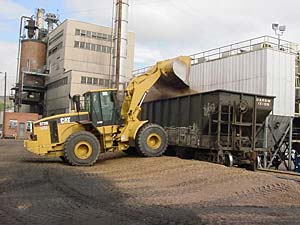
Biomass is weighed and mixed with coal for use to generate electricity for Aquila's Colorado customers. (Photo: Aquila Inc., Colorado Operations)
WHITNEY: One company that’s signed on is Aquila Energy. It runs this mid-sized power plant in Canon City that burns about 500 tons of coal a day. Plant manager Bob Gaines says that last year, the power plant started replacing about three percent of its coal intake with excess wood taken from local forests.
[SOUNDS OF POWER PLANT]
GAINES: There’s two big silos here. That go up about five floors, they hold 300 tons of coal. By the time the wood and coal get here, they’re pretty well mixed. [VOICE FADES OUT]
WHITNEY: The Aquila plant offers wood suppliers the same price as it pays for coal, and that’s motivating entrepreneurs to go out and get the overgrown trees and bring them here. Gaines says adding wood doesn’t reduce the plant’s generating capacity, but it does create some hassles.
GAINES:…And it has to go through the same chain of coal handling chutes and bunkers and things that were designed for coal, not for wood. So if we get too many big pieces it tends to plug up the coal flow.
WHITNEY: The plant also had to amend its state air quality permit when it started mixing in wood. Regulators found that burning wood doesn’t really change smokestack emissions much, but operational changes of any kind at a power plant trigger several weeks worth of red tape to get approval. That’s enough to keep most companies from even considering taking on a new fuel. So if wood is trickier to handle, opens the doors to more regulatory oversight, and is no cheaper than coal, why bother?
GAINES: Well, green tags, or renewable energy credits, are a uh, basically a nationally recognized certification that we are generating some portion of our electricity with renewable energy – in our case biomass, waste wood.
WHITNEY: The green tag certification allows Aquila to sell the renewable portion of what it generates on the open market. And it’s an expanding market. More and more states are mandating that utilities generate some power from renewable sources. If utilities don’t have enough, say, wind farms or hydroelectric power of their own, they look for certified green sources to buy it from. Many government agencies and companies have pledged to buy green power, too. Gaines says that Aquila isn’t sure yet how much their green tags might be worth.
GAINES: We’re still working on the marketing end of this ‘cause it’s fairly new for us. What we intend to do is I think initially look at some of our larger customers and invite them to buy into the renewable energy credits. And there would be a premium, but I don’t know what that would be per kilowatt hour.
|
WHITNEY: The market for green power in Colorado is poised for rapid expansion. Last fall voters passed a referendum that requires the state’s large utilities to get ten percent of their power from renewable sources by 2015. Utilities get extra credit if the renewable energy comes from an in-state source. So, here in Colorado, there’s potential to stimulate more projects that turn forest waste into electricity. DETTMAN: Well, we’ll have to see. WHITNEY: Bob Dettman works for the U.S. Forest Service in Denver. His job is to help people in the five-state Rocky Mountain region find ways to make money from all the small trees being removed to reduce fire danger. Dettman says peoples’ first concern is about air pollution. He says burning wood in a power plant is much cleaner than getting rid of it with far riskier and expensive controlled burns, and certainly cleaner than an out of control forest fire. But Dettman admits to a few roadblocks. DETTMAN: The technology’s there to burn this wood cleanly. But the economics of cutting it, skidding it, chipping it, hauling it to a site for utilization – that’s the real challenge. We’re putting a lot of focus and emphasis on how can we reduce those costs and make it all pencil out. WHITNEY: Federal grants and subsidies, and tradable green power certificates, have made burning wood for electricity pencil out for the power plant in Canon City, where plant manager Bob Gaines is working his way through this 800 ton pile of wood chips. [SOUND OF GAINES SIFTING THROUGH WOOD CHIPS] GAINES: This is ideal, right here. That’s perfect size stuff. The thing that gives us fits are the little half inch and one-inch diameter Ponderosa branches. WHITNEY: Gaines is optimistic that his plant will continue to burn wood even after the subsidies run out. GAINES: I’m starting to get phone calls now, ‘hey, I’ve got wood’. And right now I can't take it. So, I think the supply situation is changing and as we get to where we can burn more wood, we’ll help generate more supply, really. Just ‘cause there’s a market. So, it's evolving. It is changing from month to month, and it seems to be getting better. We've been kind of pushing it for four years or so…and now it’s starting to take on some momentum of its own, which I’m kind of glad to see. WHITNEY: Whether that momentum will carry over to other coal fired power plants depends on a lot of variables. New pollution restrictions on burning coal, or higher natural gas prices, could make wood power more cost competitive, as could a growing market for renewable energy certificates. But for now, there are just a handful of power plants burning wood in the U.S. Federal officials hope that this one in Canon City, Colorado, will serve as a role model for turning forest waste into a new energy source. For Living on Earth, I’m Eric Whitney. [MUSIC: “Brothers” Ry Cooder: Paris, Texas Original Motion Picture Soundtrack (Warner Bros.) 1985] Planting the Seed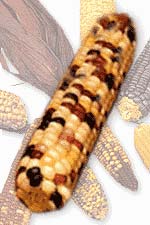
Zea Mays L. (Maize), host organism for Monsanto's MON863 (Photo: AGBIOS) CURWOOD: An internal study by the Monsanto Corporation showing kidney and blood abnormalities in lab animals fed it’s genetically engineered corn is stirring controversy in European Nations set to vote on approval of the product later this year. The study was leaked to the British newspaper The Independent on Sunday. The genetically engineered corn called MON 863 is designed to ward off damage from rootworm: a voracious pest. The Monsanto corn is already widely grown in the United States. Application has been made to the European Union for approval of MON 863, but an OK is on hold due to calls from European scientists for Monsanto to release the full one thousand-page report for public scrutiny. Among them is Dr. Brian John of the organization GM-free Wales. Dr. John, tell me why is MON 863 a cause for concern? JOHN: Well it could be dangerous because the clinical people that we’ve spoken to say that the sort of signs that are occurring in the rats, that these are very possibly pre-cancerous conditions. What they seem to be doing is there seems to be something that is causing changes to the immune system. And that, of course, when that happens, the defensive mechanisms start to kick in, and the down-the-line consequence of that may be a cancerous growth. Now, we don’t know what these links are or what the chain of events may be, but we know enough about this sort of thing to be extremely worried. And that’s why we’re arguing that great caution has to be used before, you know, before this product is assumed to be safe. It may be safe, but a great deal more science has to be done, and it has to be put in the public domain before we can come to that conclusion. CURWOOD: Can you describe for me the process of how a genetically engineered food product is approved in Europe? JOHN: Each nation state has its own advisory bodies which actually assess applications and comment on them when they’re submitted. And then the comments all go forward to Europe-wide bodies. In the case of MON 863, the application goes to a committee called the European Food Safety Authority. CURWOOD: Um-Hmm. JOHN:…and they take the comments from all the different national bodies, look at all of them. They may ask for particular pieces of research to be done by the applicant, in this case Monsanto. And then they sit down and come up with a piece of advice saying either that this product is OK, or that it’s not OK. And this advice then goes through to the commission, and again, it has to be approved by the member states of Europe. And in the case of MON 863, the member states have not yet been able to come to a view on it, because there is widespread disagreement about how safe it is. CURWOOD: What would you like to see happen as a result of all this controversy over this genetically modified corn in Europe? JOHN: I would like to see some decent science done, for a start, with genuine peer review, and comprehensive studies undertaken as to the effects of genetic modification on plants which are going into the food chain. CURWOOD: That’s Doctor Brian John from the organization GM-Free Wales. And joining me now is Mark Shapiro at the Center for Investigative Reporting. He’s written extensively about the Genetically Modified food industry. Um, Mark, if I have a new genetically modified product I want to bring to a market here in the United States, where do I go to get approval? SHAPIRO: You have to go to the USDA, which will review your new product, and if your new product contains its own insecticide – if it contains a poison that’s going to poison a pest – then you have to bring it to the Environmental Protection Agency. And the Environmental Protection Agency relies on studies conducted by the companies themselves as to the toxicity of your particular new variety in the field. CURWOOD: Now what about the food safety issue? Do I have to take this to the Food and Drug Administration to get approval to sell it to the public as a foodstuff? SHAPIRO: The answer is no. The FDA has what it calls “voluntary safety consultations” with the biotech companies. And they review, periodically, the safety data supplied by the companies. But not once over the past ten years has it refused to permit development of new GE crop varieties to move ahead. CURWOOD: Now, what percentage of crops in the United States are genetically modified?
|

